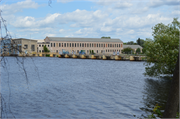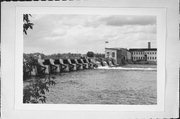Property Record
MENOMINEE RIVER .1 MI W OF HATTIE ST BRIDGE
Architecture and History Inventory
| Historic Name: | |
|---|---|
| Other Name: | |
| Contributing: | |
| Reference Number: | 23009 |
| Location (Address): | MENOMINEE RIVER .1 MI W OF HATTIE ST BRIDGE |
|---|---|
| County: | Marinette |
| City: | Marinette |
| Township/Village: | |
| Unincorporated Community: | |
| Town: | |
| Range: | |
| Direction: | |
| Section: | |
| Quarter Section: | |
| Quarter/Quarter Section: |
| Year Built: | |
|---|---|
| Additions: | |
| Survey Date: | 19852015 |
| Historic Use: | dam/lock |
| Architectural Style: | NA (unknown or not a building) |
| Structural System: | |
| Wall Material: | Concrete |
| Architect: | |
| Other Buildings On Site: | |
| Demolished?: | No |
| Demolished Date: |
| National/State Register Listing Name: | Not listed |
|---|---|
| National Register Listing Date: | |
| State Register Listing Date: |
| Additional Information: | INDUSTRIAL BLDGS IN PHOTO LOCATED ON MICHIGAN SIDE OF RIVER Resurveyed July 2015. This early 2Q1h-century concrete gravity dam is approximately 660 feet in length and spans the Menominee River from the south (Wisconsin) bank to the north (Michigan) bank. The dam was constructed before 1938. From south (Wisconsin) to north (Michigan), the dam consists of one section with twelve tainter gates and a three-bay overflow spillway. Concrete piers separate the spillway sections and frame the tainter gates. A walkway with steel rails spans the top of the dam. Several historic industrial buildings are connected to and built onto the north (Michigan) end of the dam. The south (Wisconsin) end of the dam is undeveloped, with a heavily tree-lined bank and a grassy area along Riverside Avenue. The existing dam is located on the spot of several previous dams, the earliest of which was constructed prior to 1884. The dams at this location provided power and growth impetus for industrial production on both sides of the river. On the south (Wisconsin) side, the Marinette Flour Mill Company and the Marinette & Menominee Paper Co. Mill No. 1 were located between the dam and Hattie Street on the location of present-day Riverside Avenue. After the paper mill relocated in 1920 (see record for 3120 Riverside Avenue), and the flour mill closed in 1923, the former industrial buildings were demolished and portions of the site were developed into residential parcels along Riverside Avenue. On the north (Michigan) side of the river, several historic industrial buildings remain connected to the dam, including the still-operational 1924 Menominee Hydroelectric Plant. This Neoclassical-style building appears to retain good integrity and continues to function as a power utility. Despite the loss of the industrial buildings in Marinette, the dam retains its significance for its association with Menominee's public utilities. The dam appears to be in good condition and retains a good degree of integrity. However, the dam does not display any exceptional engineering principles or design characteristics. No information was found to suggest that this dam might be more significant than any of the other dams along the Menominee River in the City of Marinette. Adjacent project activities will reconstruct the curb and gutter in-kind. The location of the curb line will not move. Riverside Avenue will be narrowed slightly on the south (opposite) side of the street. The dam is set back approximately 50ft from the curbline and is further buffered by a grass area and foliage. Since the project activities have minimal potential to affect the dam, its setting, or any of its character-defining features, a DOE is not recommended. The dam was previously surveyed in 1985. No subsequent changes are visible. The AHI record was updated with the new survey date and unchanged appearance. The Marinette and Menominee Paper Company Mill No. 2 was constructed in 1906-07 by the O'Keefe and Orbison Engineering and Construction Company, while the attached powerhouse and dam over the Menominee River were constructed in 1924 by Oshkosh engineering company C.R. Meyer and Sons. The property is T-shaped in plan and made up of five interconnected sections. Section 1 of the paper mill is a long narrow brick building resting on a rock-faced stone ashlar foundation with an asphalt shingled, gabled roof, and is comprised of a one-story part and two-story part. The one story part of Section 1 was built as a finishing room, while the two-story part housed two large paper machines. Sections 2 and 3 are also made of brick with stone foundations and metal gabled roofs; Section 2 was originally the beater room, while section three had both a wood room as well as a wet machine. Sections 1, 2, and 3 all feature regularly spaced window openings, many retaining their original12-over-12 or 16-over-16 sash windows, with some openings bricked in or containing replacement windows. Section 4 was originally the grinder room, and was later altered to accommodate two turbines and a traveling crane. It features a concrete foundation and first story, with a metal-sided second story. Alterations in 1977 resulted in addition of a second story and the filling or downsizing of the windows on the first story. Section 5 consists of the Powerhouse, which extends out over the river, and attached dam. Both were constructed in 1924. The Section 5 Powerhouse is a one-story shed-roofed structure, constructed of reinforced concrete on a poured concrete foundation. Windows are multi-paned industrial sashes separated by concrete pilasters, with concrete corbelling on the cornice. The Menominee Dam extends south across the river to Marinette. It is a concrete gravity dam measuring 456 feet long and 26 feet high, and is comprised of 12 tainter gates set in concrete piers, a 3-part ogee spillway, and an 8- foot wide fishway adjacent to the Powerhouse. A walkway with steel rails spans the top of the dam. Section 4 is the most altered of the Mill buildings, with its 1977 alterations and second-story addition. The mill complex has also lost several sections, the most prominent of which are a warehouse that was located north of Section 1, a boiler room that was located in the ell formed by Sections 2 and 3 on the north facade, and a water tower. All were removed after 1963. The Menominee Dam has experienced routine maintenance since its construction in 1924, but no major alterations. |
|---|---|
| Bibliographic References: |
| Wisconsin Architecture and History Inventory, State Historic Preservation Office, Wisconsin Historical Society, Madison, Wisconsin |



